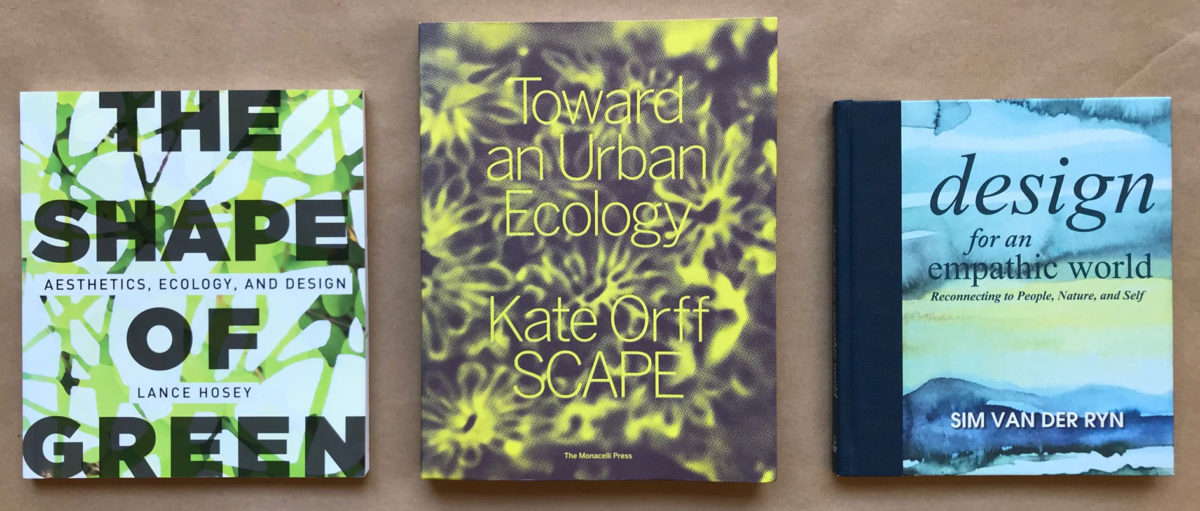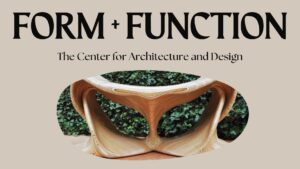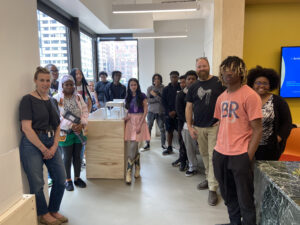
Spring is here and Baltimore is in bloom. Spend an afternoon in the park with one of these books that show how going green makes the world around us a more sustainable, healthy, and beautiful place.
The Shape of Green: Aesthetics, Ecology, and Design
By Lance Hosey
Paperback: 216 pages
Does going green change the face of design or only its content? The first book to outline principles for the aesthetics of sustainable design, The Shape of Green argues that beauty is inherent to sustainability, for how things look and feel is as important as how they’re made.
In addition to examining what makes something attractive or emotionally pleasing, Hosey connects these questions with practical design challenges. Can the shape of a car make it more aerodynamic and more attractive at the same time? Could buildings be constructed of porous materials that simultaneously clean the air and soothe the skin? Can cities become verdant, productive landscapes instead of wastelands of concrete?
Drawing from a wealth of scientific research, Hosey demonstrates that form and image can enhance conservation, comfort, and community at every scale of design, from products to buildings to cities. Fully embracing the principles of ecology could revolutionize every aspect of design, in substance and in style. Aesthetic attraction isn’t a superficial concern — it’s an environmental imperative. Beauty could save the planet.
Toward an Urban Ecology: SCAPE / Landscape Architecture
By Kate Orff
Paperback: 272 pages
Part monograph, part manual, part manifesto, Toward an Urban Ecology reconceives urban landscape design as a form of activism, demonstrating how to move beyond familiar and increasingly outmoded ways of thinking about environmental, urban, and social issues as separate domains; and advocating for the synthesis of practice to create a truly urban ecology. The book depicts a range of participatory and science-based strategies through the lens of SCAPE’s practice, featuring projects, collaborators, and invited essays on urban ecological design.
The themes of Revive, Cohabit, Engage, and Scale serve as the framework for the book. These chapters provide forward-thinking and celebratory design provocations that can catalyze chance and arm the reader with a way of thinking and acting ecologically across systems. Combining design, research, art, and environmental knowledge in order to advance landscape architecture as a form of activism, the practice has yielded a synthetic vision of landscape, infrastructure, and community. We hope that it will inspire you to synthesize everything that you know, to marshal your own personal talents, and to work toward an urban ecology.
Design for an Empathic World: Reconnecting People, Nature, and Self
By Sim Van Der Ryn
Hardcover: 192 pages
Despite an uncertain economy, the market for green building is exploding. The US green building market has expanded dramatically since 2008 and is projected to double in size by 2015 (from $42 billion in construction starts to $135 billion). But green-building pioneer Sim Van der Ryn says, “greening” our buildings is not enough. He advocates for “empathic design”, in which a designer not only works in concert with nature, but with an understanding of and empathy for the end user and for ones self. It is not just one of these connections, but all three that are necessary to design for a future that is more humane, equitable, and resilient.
Sim’s lifelong focus has been in shifting the paradigm in architecture and design. Instead of thinking about design primarily in relation to the infrastructure we live in and with—everything from buildings to wireless routing—he advocates for a focus on the people who use and are affected by this infrastructure. Basic design must include a real understanding of human ecology or end-user preferences. Understanding ones motivations and spirituality, Sim believes, is critical to designing with empathy for natural and human communities.
In Design for an Empathic World Van der Ryn shares his thoughts and experience about the design of our world today. With a focus on the strengths and weaknesses in our approach to the design of our communities, regions, and buildings he looks at promising trends and projects that demonstrate how we can help create a better world for others and ourselves. Architects, urban designers, and students of architecture will all enjoy this beautifully illustrated book drawing on a rich and revered career of a noted leader in their field. The journey described in Design for an Empathic World will help to inspire change and foster the collaboration and thoughtfulness necessary to achieve a more empathic future.
April Reading List – Going Green
Latest Gallery and Bookstore

July 1, 2024 / Center for Architecture and Design
Form + Function: AIA Baltimore exhibits the work of David Knopp
June 23, 2023 / Center for Architecture and Design
Alberto Cavalieri Work on View at Center for Architecture and Design

April 18, 2023 / Center for Architecture and Design
Baltimore Design School Architecture II Student exhibit on display now!